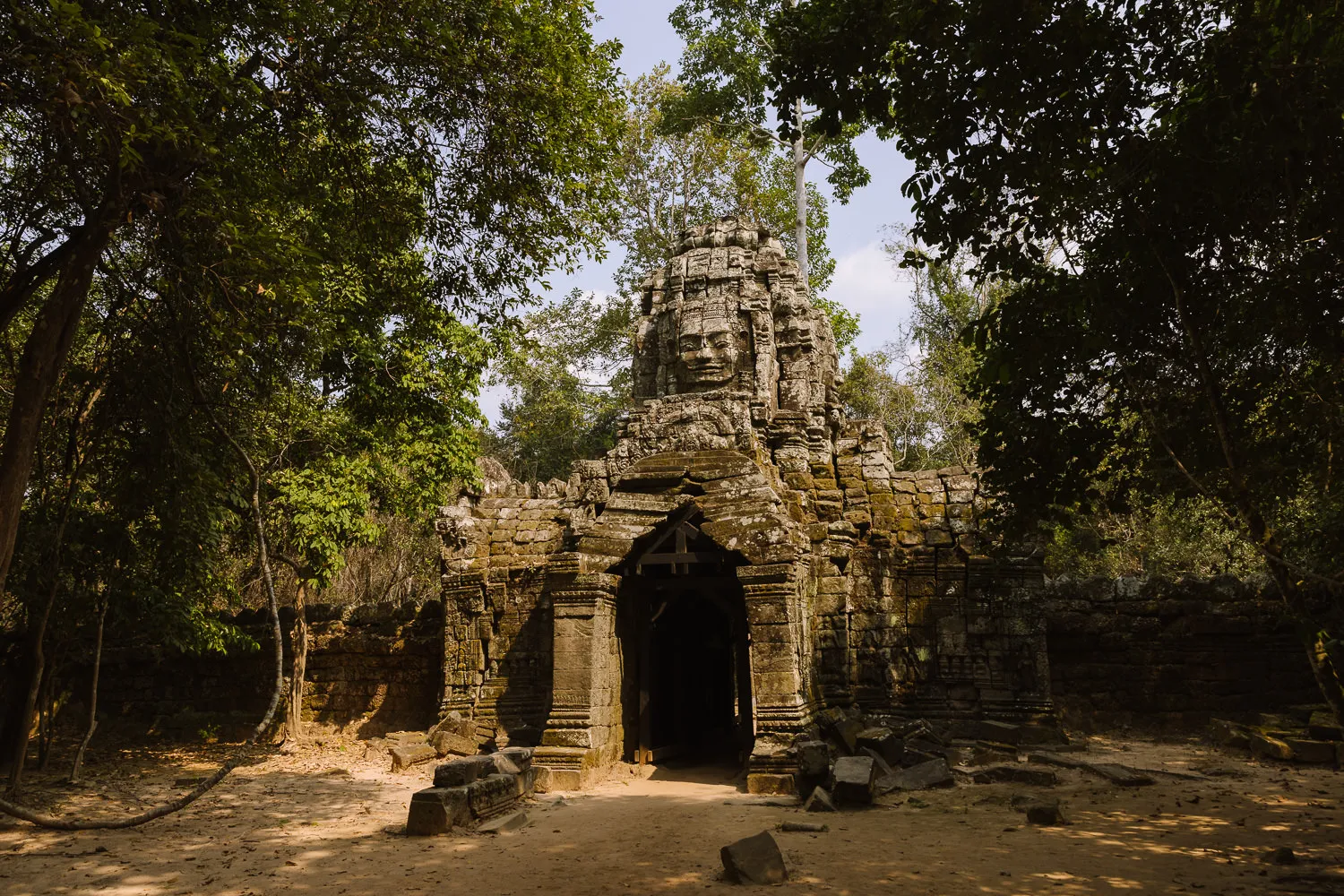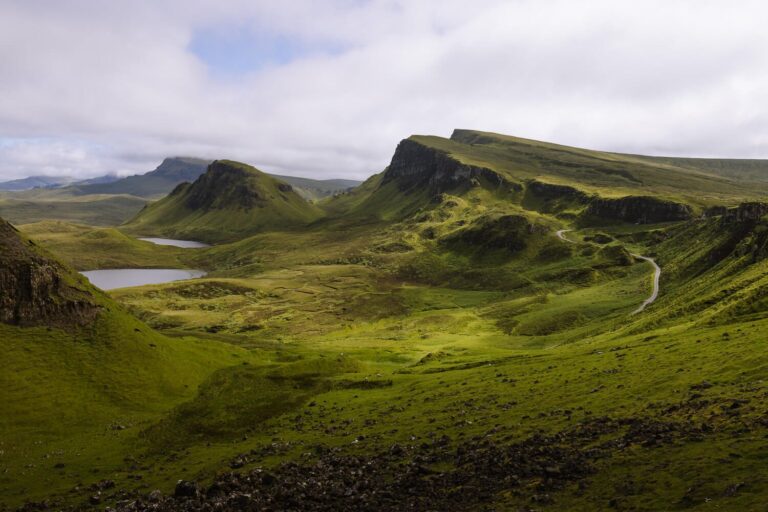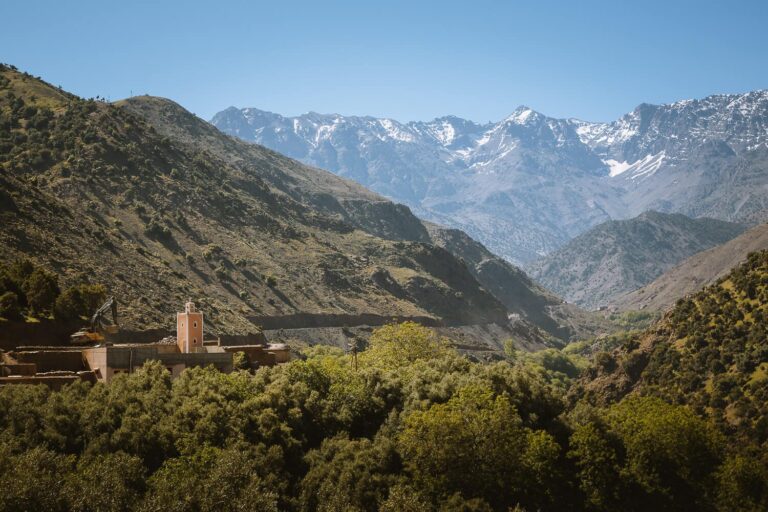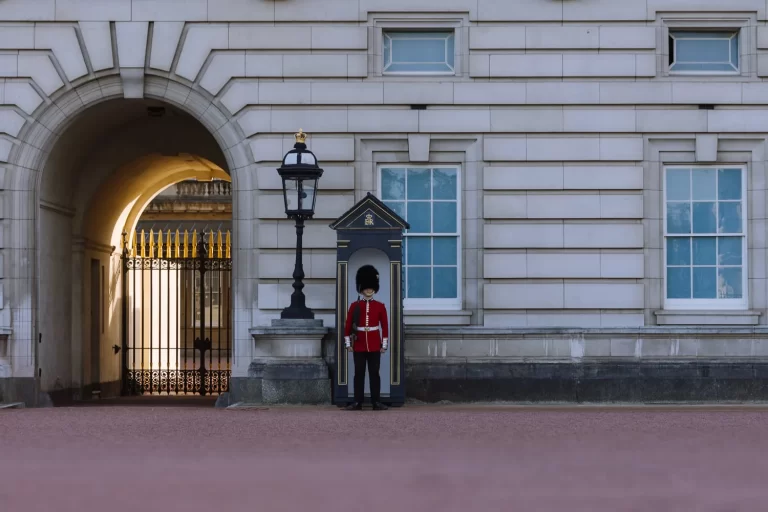Angkor Wat Grand Circuit: Self-Guided Route (+ Map) | Anywhere We Roam
The Grand Circuit is a circular loop that passes many of the lesser-known Angkor temples near Siem Reap. It’s great for getting off the beaten track. Here’s how best to do the circuit including tips on when to go and which temples to see.
By: Mark Barnes |
Published: 14 Mar 2024
The Khmer Empire built impressive and elaborate temples dedicated to their religion which are scattered around the city of Siem Reap.
The most impressive temples can be visited on a circular route called the Small Circuit. But to get off the tourist trail a little, we highly recommend a second route called the Grand Circuit.
Less visited, but no less remarkable, the Grand Circuit temples are more decayed, more wild and more lost-world. They include intriguing pyramid structures, Greek-like libraries, and ruins consumed by the forest.
It’s a great thing to do if you are spending more than 2 days in Siem Reap and like to get a bit off the beaten track.
We have included a map of the route, recommended temples to visit and tips for organising your self-guided tour.

MAP – ANGKOR WAT GRAND CIRCUIT
There are two circuits of the central Angkor Temples. The Small Circuit visits the most famous and significant temples; the Grand Circuit visits other temples which are less important, but no less impressive.
If you only have time for one, you should do the Angkor Small Circuit.
But it’s well worth doing the Grand Circuit as well. The temples are all a bit different and much quieter.
The 26-kilometre Grand Circuit is marked in red on the map below along with all the major sights and recommended parking spots.
How to use this map / Click on the top left of the map to display the list of locations, then click on the locations to display further information. Click on the top right corner of the map to open a larger version in a new tab or the star to save to your Google Maps.
HOW TO DO THE GRAND CIRCUIT TOUR
There are several ways to complete the Grand Circuit.
TUK-TUK
Hiring a Tuk-Tuk driver is an excellent way to see the Small Circuit because you get a shady drive, giving you time to cool off between the temples. Expect to pay around $15 for the day with water provided by your driver. Sunrise or sunset trips may cost a little extra.
You can easily book a tuk-tuk through your guesthouse or from tour providers in town. Once you find your first Tuk-Tuk driver they will most likely want to exchange WhatsApp numbers to take you out on subsequent days.
English-Speaking Guide – Your guesthouse will be able to arrange an English-speaking guide to take you through the temples explaining the history and layout. Expect to pay another $10 for the guide, in addition to the Tuk-Tuk driver. Alternatively, you’ll find guides offering their services as you approach each temple.


SCOOTER
Another option to see the Small Circuit is to hire your own scooter and self-drive, following the map and walking route above. Scooters cost $5-8 a day to hire and usually come with unlimited mileage.
The roads around the temples are not very busy, but there is quite a bit of traffic on the road from Siem Reap to get to the start of the Grand Circuit.
It’s also a lot of fun, but it can also get a bit hot.

BIKE
The first time we did the small circuit we went by bicycle ($3-5 to rent). It’s a great way to explore the temple area, but it’s a 45-minute ride from the centre of Siem Reap to the start of the circuit and 45 minutes back again at the end of the day.
If you include the many hours spent walking around the temples in hot temperatures, we think it’s better to go by tuk-tuk or scooter. Furthermore, if you want to see sunrise or sunset you’ll be cycling there or back in the dark.
TAXI
A taxi tour ($27) is just like a tuk-tuk tour except you’ll have air conditioning and it’ll be a tiny bit quicker. But it’s more expensive and nowhere near as much fun.


ANGKOR WAT GRAND CIRCUIT TOUR
We have ranked all the temples to help you choose which ones to visit. All the temples in the area including the outer temples are in our best Angkor Temples guide.
1. PRE RUP
Our Rating – ★★★☆☆ | Worth a stop | Time to Visit – 40 minutes.
Built from grey sandstone, Pre Rup has decayed quicker than other temples, giving it even more of a worn, crumbling appearance than many other Angkor temples.
From a series of galleries and walkways you can spot lion statues guarding doorways, crumbling stone columns and once intricate lintels. The long staircase leading up the 3-stepped pyramid to the upper level with 5 towers was our highlight.
Pre Rup is one of the few temples open at both sunrise and sunset. However, with no views and high trees surrounding it, it’s not the best place to be for either.


2. EAST MEBON
Our Rating – ★★☆☆☆ | Checkout the elephants | Time to Visit – 40 minutes.
East Mebon is a pyramid of terraces with beautiful sculptures and statues. The highlight is the 2-metre-high elephants adorning each corner.
Originally, the temple was located on an artificial island in a large body of water and was only accessible by boat. The water is long gone, but the temple remains in a layout of multiple courtyards and towers.
We liked visiting but unfortunately, there was quite a bit of scaffolding. See the elephant statues and head inside if the scaffolding has gone.


3. TA SOM
Our Rating – ★★★☆☆ | Walk all the way through to the eastern gate | Time to Visit – 45 minutes.
Ta Som is an atmospheric temple that has been carefully restored over the years. It’s been held up in places, but not so much that it ruins the crumbling effect.
There are some remarkable stone carvings, and the jungle setting makes it a captivating place to stroll around.
Make sure you head all the way through the temple to the far eastern gate. The tree consuming the gate has been cut back extensively but the roots over the entrance remain. It’s lost some of its allure since our first visit but it’s still a good sight.




4. NORTH BARAY
Our Rating – ★★★★☆ | Stop to photograph the Baray | Time to Visit – 15 minutes.
The reservoirs that surround the Angkor temples are remarkable. One of the most spectacular is the North Baray also called Jaytataka Baray. Measuring 3,600 metres by 900 metre it’s a colossal man-made lake.
A wooden boardwalk (that heads across the water to Neak Pean) offers an excellent viewing platform over the reservoir. It is often covered in lilies and backed by dead trees poking above the water.

5. NEAK PEAN
Our Rating – ★★☆☆☆ | Can skip if short on time | Time to Visit – 30 minutes.
Neak Pean (sometimes spelt Neak Poan) is a Buddhist temple on a man-made island in the centre of the Northern Baray.
The central shrine, rising from a double circular lotus-styled base, sits at the centre of a large basin, The temple is nice enough, but it’s the walk over the Northern Baray that makes coming here special.

6. BANTEAY PREI
Our Rating – ★★☆☆☆ | Skip unless its wet season | Time to Visit – 20 minutes.
Just off the Grand Circuit you’ll find Prasat Prei and a little further on Banteay Prei. Only partially restored the site presents a very natural atmosphere and it’s usually very quiet.
The temples were built during the Jayavarman VII era in the late 12th to early 13th century. They are best seen in the wet season when the moat surrounding them fills with water. Otherwise, you can easily skip both.
7. PREAH KAHN
Our Rating – ★★★★☆ | Essential stop on the Grand Circuit | Time to Visit – 90 minutes.
The most impressive Angkor Temples are on the Small Circuit, but Preah Kahn is an exception. Consumed by the jungle it is a lot like Ta Prohm, but much less visited. It’s one of the largest temples built during the Khmer empire and the decaying remains are well worth visiting.
A 100-metre-long causeway, flanked by giants holding a Naga, crosses a moat to enter the complex made up of 4 enclosures. Each one converging on the Main Sanctuary, a perfect square in the centre.
Many of the carvings are in excellent condition and it’s one of the most interesting temples to visit which remains relatively quiet.
There are a few highlights to seek out.
- Gigantic tree roots surrounding the eastern wall.
- The Greek-looking library in the eastern section of the temple.
- A maze of rambling corridors converging on the central stupa in the Main Sanctuary.



8. NORTH GATE ANGKOR THOM
Our Rating – ★★★☆☆ | Quick easy stop | Time to Visit – 15 minutes.
The Grand Circuit now passes into Angkor Thom through the North Gate. The gate is similar to the more visited South Gate but with a more rustic and less restored look.
It’s an atmospheric place, and well worth a quick stop.
The Grand Circuit now winds through Angkor Thom and passes the entrance to Angkor Wat. These two temples are usually visited on the Small Circuit, but if you have time there is nothing to prevent you adding them onto this tour.

HOW LONG DOES IT TAKE TO DO THE GRAND CIRCUIT?
On the Grand Circuit there are three temples you should definitely visit – Preah Kahn, Ta Som, and Pre Rup. If you only stopped at these three, the circuit takes about 4 – 5 hours.
However, we suggest you also explore the North Baray, the elephant statues at East Mebon, and stop for photos at Angkor Thom North Gate. Add in a break at one of the many lunch spots on route and it’s better to allow 5 – 6 hours.
You can easily extend the circuit by adding in stops on the Small Circuit that you pass on the way including Angkor Thom and Angkor Wat. Try to time your trip to be at Phnom Bakheng for sunset.

BEST TIME TO DO THE GRAND CIRCUIT TOUR
The temples open from 7:30 am to 5:30 pm with a few exceptions which allow you to visit at sunrise and sunset.
- Angkor Wat – 5 am to 5:30 pm
- Pre Rup – 5 am to 7pm
- Phnom Bakheng – 5 am to 7pm
You can do the Grand Circuit any time within these hours and in either direction.
We suggest leaving mid-morning and completing the Grand Circuit in an anticlockwise direction. This should mean you are driving past Angkor Wat in late afternoon when the light streams onto its wonderful façade. After grabbing some photos head back to Phnom Bakheng and (if you have the energy) climb to the summit for sunset.
TICKETS FOR ANGKOR TEMPLES
sit the Angkor Temples near Siem Reap you need a pass from Angkor Enterprise. You can purchase the pass at the entrance gate to the main Angkor temples, but it can take time.
It’s much more convenient to purchase them in advance online. The pass can then be stored on your phone to show as you enter each temple.
There are three types of tickets:
- 1-Day Pas ($37) – Entry to all the Angkor temples for 1 day.
- 3-Day Pass ($62) – Entry to all the Angkor temples for any 3 days in a 10-day period.
- 7-Day Pass ($72) – Entry to all the above temples for any 7 days in a 1-month period.
The pass will be scanned at the entrance to most of the major temples to monitor how many days have been used. Children under the age of 12 are free but must show their passports.


MORE READING
Here is some more useful reading for your trip to Cambodia.









